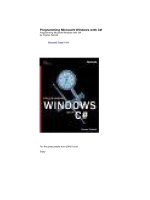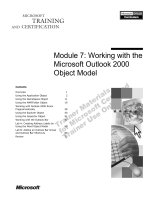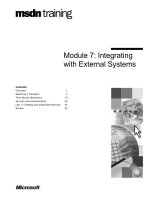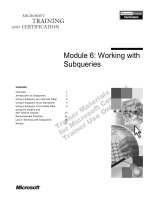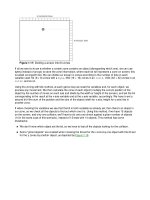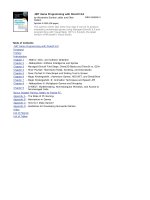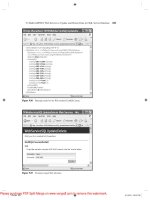Tài liệu Grome Terrain Modeling with Ogre3D, UDK, and Unity3D docx
Bạn đang xem bản rút gọn của tài liệu. Xem và tải ngay bản đầy đủ của tài liệu tại đây (6.42 MB, 162 trang )
www.it-ebooks.info
Grome Terrain Modeling with
Ogre3D, UDK, and Unity3D
Create massive terrains and export them to the
most popular game engines
Richard A. Hawley
BIRMINGHAM - MUMBAI
www.it-ebooks.info
Grome Terrain Modeling with Ogre3D, UDK,
and Unity3D
Copyright © 2013 Packt Publishing
All rights reserved. No part of this book may be reproduced, stored in a retrieval
system, or transmitted in any form or by any means, without the prior written
permission of the publisher, except in the case of brief quotations embedded in
critical articles or reviews.
Every effort has been made in the preparation of this book to ensure the accuracy
of the information presented. However, the information contained in this book is
sold without warranty, either express or implied. Neither the author, nor Packt
Publishing, and its dealers and distributors will be held liable for any damages
caused or alleged to be caused directly or indirectly by this book.
Packt Publishing has endeavored to provide trademark information about all of the
companies and products mentioned in this book by the appropriate use of capitals.
However, Packt Publishing cannot guarantee the accuracy of this information.
First published: February 2013
Production Reference: 1110213
Published by Packt Publishing Ltd.
Livery Place
35 Livery Street
Birmingham B3 2PB, UK.
ISBN 978-1-84969-939-6
www.packtpub.com
Cover Image by Neha Rajappan ()
www.it-ebooks.info
Credits
Author
Richard A. Hawley
Reviewer
Adrian Licuriceanu
Stefano Provenzano
Acquisition Editor
Mary Nadar
Content Commissioning
Editor
Meeta Rajani
Technical Editor
Worrell Lewis
Project Coordinator
Esha Thakker
Proofreader
Mario Cecere
Indexer
Monica Ajmera
Graphics
Valentina D’silva
Production Coordinator
Pooja Chiplunkar
Cover Work
Pooja Chiplunkar
www.it-ebooks.info
About the Author
Richard Hawley started programming in the early 1980s at the start of the home
computer craze with the Sinclair ZX-81. Before leaving high school he had worked
on three game projects for Assassin Software and later worked on conversions
of classic strategy board games for 8- to 16-bit machines. He went on to develop
end-user tools for popular ight simulations including Empire Interactive’s Enemy
Engaged helicopter series and the highly successful Origin Jane’s Longbow series
(MissioneerPlus).
He’s the director of Tricubic Studios, a small UK company dedicated to creating
simulation and training environments using off-the-shelf 3D engines including
Unity and Leadwerks. Together with technical artist David Hopkinson (Total War:
English Civil War conversion) and physics guru Fred Naar (creator of Helicopter
Total Realism for Microsoft Flight Simulator X) they are collectively known for
their work on helicopter simulations.
I would like to thank my wife Dorothy for putting up with my
long sabbaticals in front of the computer and my kids who have
grown used to becoming experimental subjects on family board
gaming nights.
People I’ve had the privilege to work with; David Hopkinson
for being a patient sounding board throughout our joint creative
endeavors, his talent of being able to make silk purses out of sow’s
ears is a testament to his ingenuity. I’d also like to thank Fred Naar
who not only created the most amazing and unique helicopter
physics engine but who also is a really nice guy. Other thanks go to
Rob Hardaway for years of designing impossible mission scenarios,
but mostly for hanging around at ight simulation shows being
mistaken for me (which I’m more than happy about since he’s six
foot tall and ghter-pilot handsome).
www.it-ebooks.info
Thanks to Adrian Licuriceanu at Quad Software for his technical
support with Grome, and for playing the role of accuracy police for
this book.
Finally, a big thank you to the simulation community, SimHQ, and
various individuals that continue to be supportive in the face of my
endless and annoying prevarication and distractions (of which this
book is but one of them). Sorry!
Art is never nished, only abandoned.
www.it-ebooks.info
About the Reviewers
Adrian Licuriceanu started programming from an early age. Later, in both high
school and college, he studied computer science and from the very beginning was
fascinated with graphics programming. After graduating from college, in 2000, when
a funding opportunity arrived, he founded Quad Software with the aim of creating
technology for Massively Multiplayer Games. During the 5 years that he was the
lead programmer he developed two engines used for MMO games. Later, he built
on the previous experience to create Grome, a game-level editor currently employed
by many professional studios. After two years of internal development, together
with a small team of programmers, they managed to bring Grome to commercial
quality and successfully launched the product in 2007. Currently, Grome is at its
third version and it is used by many top professional game studios, simulation
industry corporations, and universities. After another two years from the initial
Grome launch, Adrian and his team made public the Graphite engine, the rendering
middleware companion to Grome, an engine that can be used to render the complex
scenes Grome can produce.
Stefano Provenzano is an Italian senior consultant and software engineer, who
has worked on several projects in different elds of computer science including 3D
real-time engines for PC and Playstation videogames, visual simulation and virtual
prototyping, web application, and system integration.
In 2006, Stefano started his own software development and consulting company,
Shin Software. Currently, Stefano is working on RIA and hi-quality mobile/web 3D
real-time applications using Unity3D.
To my wife Irene and our children Davide and Pietro, your love
gives me the strength to work and study hard.
www.it-ebooks.info
www.PacktPub.com
Support les, eBooks, discount offers
and more
You might want to visit www.PacktPub.com for support les and downloads related to
your book.
Did you know that Packt offers eBook versions of every book published, with PDF and ePub
les available? You can upgrade to the eBook version at www.PacktPub.com and as a print
book customer, you are entitled to a discount on the eBook copy. Get in touch with us at
for more details.
At www.PacktPub.com, you can also read a collection of free technical articles, sign up
for a range of free newsletters and receive exclusive discounts and offers on Packt books
and eBooks.
TM
Do you need instant solutions to your IT questions? PacktLib is Packt’s online digital book
library. Here, you can access, read and search across Packt’s entire library of books.
Why Subscribe?
• Fully searchable across every book published by Packt
• Copy and paste, print and bookmark content
• On demand and accessible via web browser
Free Access for Packt account holders
If you have an account with Packt at www.PacktPub.com, you can use this to access
PacktLib today and view nine entirely free books. Simply use your login credentials for
immediate access.
www.it-ebooks.info
www.it-ebooks.info
Table of Contents
Preface 1
Chapter 1: Creating Virtual Landscapes 5
Describing a world in data 6
Heightmaps are common ground 6
Texture sizes 8
The huge world problem 9
Floating point precision 9
Depth buffer precision 10
Planning our rst project – the brief 11
Starting GROME 13
Summary 16
Chapter 2: GROME Workspace 17
Viewports 18
Selecting objects 18
Workspace panel 19
Workspace tab 19
Scene tab 19
Layer stack 20
Layer type selector 22
Selection lter 22
Tools panel 23
Workow/creation path 23
Zones 24
Know the dimensions 26
Zone splitter 26
www.it-ebooks.info
Table of Contents
[ ii ]
Example – volcano island 26
Splitting zones 28
Creating a simple procedural heightmap 30
Summary 31
Chapter 3: Heightmaps 33
Modier toolsets 33
Heightmap toolset 34
Elevation 34
SurfInfo 35
Erosion and FLErosion 35
HmapImport 36
Resampler 36
HSmooth 36
HmapStamp 36
ObjLevel 37
Simplify 37
Heightmap Brush toolset 37
Elevation 38
Smudge 38
Smooth 38
Clone 39
Fractals, hills, mountains, and dunes 39
Procedural Heightmap toolset 39
PDeposition 39
FractalNoise and FractalDunes 39
Example – the Heightmap layer stack 40
Heightmap layer operations 44
Merging a heightmap 45
Flatten down 45
Selection masks 45
Example – putting it together 48
Our initial work plan 48
Now to apply the River feature 52
Brushing the shoreline 53
Summary 53
Chapter 4: Textures and Lighting 55
Performance consideration for mobiles 55
Working with material layers 56
Assigning zones to a layer 56
Color textures 58
Ground holes 58
Masked textures 59
The texture toolset 60
www.it-ebooks.info
Table of Contents
[ iii ]
ColorGen tool 61
Distribution Mask component 62
Layers and Layers in use 63
Shadowmap tool 64
MaskFilter tool 66
MaskGen tool 66
The Base layer 67
The 01 layer 67
Arm 02 Texture layer 67
Final Detail layer 68
All done 68
Vertical texture mapping 68
ColorBake tool 70
NormalMap tool 72
Let it snow 72
The brush tools 73
The package browser 74
Decals 74
Summary 77
Chapter 5: Bring Me a Shrubbery 79
Exportability of vegetation 80
GROME detail objects and billboards 81
The Detail layer stack 81
Adding grass billboards 82
Adding 3D Object details 84
The Detail toolset 85
Brush tool 85
Mask tool 86
Procedural tools 86
3D Objects in detail layers 90
Summary 91
Chapter 6: Water, Rivers, and Roads 93
Water layers 94
Creating a new water layer 94
Masks 95
Global settings 96
Waves 96
Coloring 97
Lighting 97
Shadows on water layers 97
Water toolset 98
Generator tool 98
Shoreline tool 99
www.it-ebooks.info
Table of Contents
[ iv ]
Creating rivers 100
Creating a small stepped river feature 100
Roads 101
Create tool 102
Adding more roads to create a network 104
Adjust tool 104
Congure tool 105
Texturing the road 108
Real road data 109
Summary 110
Chapter 7: Exporting to Unity, UDK, and Ogre 3D 111
Unity 111
Desktop PC/Mac 112
Export RAW terrain 112
Exporting from GROME 113
Importing into Unity 114
Importing Unity Splatmaps 115
Convert texture to ARGBA32 format 116
Unity editor script to replace splatmaps 117
Mesh terrain export 119
Mesh export from GROME 120
Unreal Development Kit 124
GROME export plugin for UDK 124
Ogre3D 131
OgreGraphite engine 132
Exporting with GraphiTE 133
Compiling the code 135
Deleting zones 136
Going further – the edge of forever 137
Summary 137
Index 139
www.it-ebooks.info
Preface
Role-playing games and simulations can feature vast landscapes. Whether shaped
by imagination or real geography the amount of data is potentially huge. GROME is
ideally
suited for ground modeling of large terrains with memory paging and
procedural-generation techniques.
Now in its third generation, GROME 3.1 has evolved to meet the specic needs of
developers and artists creating detailed, dynamically-loaded landscapes. New
features support the creation of simple meshes from highly-detailed terrain suitable
for use in mobile games and improved owmap generation.
Used in the production of console games and simulation labs worldwide, GROME
3.1 is supplied with Software Development Kits (SDKs) to aid the production
process. Like any specialist tool, it can be somewhat intimidating to the newcomer.
This book is designed
to assist readers, new to using GROME 3.1, and guide them through in a
logical order.
What this book covers
Chapter 1, Creating Virtual Landscapes, looks at the concept of map storage in games,
limitations imposed by 3D technology, and starting a new GROME project.
Chapter 2, GROME Workspace, walks us through the major parts of the user interface
that we will be using through the rest of the book. Then we begin the process of
creating “zones” which are the basic components of a terrain.
Chapter 3, Heightmaps, looks at the bulk of the tools used for modeling heightmaps;
using brush and automatic procedural techniques combined. We round this off with
a look at using masks to protect regions from modication. This also contains the
obligatory “Hello World” example, but in heightmap form.
www.it-ebooks.info
Preface
[ 2 ]
Chapter 4, Textures and Lighting, covers using textures and masks combined to blend
different layers together. We also look at owmaps, automatic mask generation,
lters, shadow maps, and light maps. Additionally, we look at color baking for
squashing multiple texture layers into one, for mobile support and normal maps.
Chapter 5, Bring Me a Shrubbery, explores the special support for vegetation using
billboards and instances of 3D objects. Ground details greatly enhance a scene, as
hardware becomes more powerful, more details can be added. Ground cover can be
generated procedurally to create huge areas of ground detail.
Chapter 6, Water, River, and Roads, walks us through the water toolset, creating
multiple water layers, material properties, adding shorelines, and creating roads
using the spline tools.
Chapter 7, Exporting to Unity, UDK, and Ogre 3D, helps us export basic terrains using
several techniques for Unity3D. Then we cover a 3D mesh export for UDK as a basic
ground layer. Then nally we use the Graphite exporter which creates near 100
percent compatible GROME scenes when using the GromeOgre source code.
What you need for this book
A licensed installation of GROME 3.x or an evaluation (which has no export or
saving facility but can be used for most of the presented tutorials). For download
details, please see the ofcial vendor’s website:
www.quadsoftware.com
Unity3D game engine is available free for non-commercial use from:
www.unity3d.com
Unreal Development Kit (UDK) is available for non-commercial use from:
www.udk.com
Ogre3D is a free open source rendering engine. Visual Studio 2005 to 2010 can be
used to compile any of the GROME examples in addition to the Graphite library
which is available to licensed GROME clients. Ogre3D can be downloaded from:
www.ogre3d.org
www.it-ebooks.info
Preface
[ 3 ]
Please be sure to read the licensing terms when downloading and installing these
engines. Your computer should also meet the following specications:
• Windows XP SP2 or higher
• 4 MB of RAM, or more, if using a 64-bit OS (recommended)
• Graphics card with 256 MB VRAM and at least four texture units
Who this book is for
If you’re a developer or technical artist looking for a companion guide to walk you
through GROME 3.1 then this book will help you through those early steps through
practical use.
Due to the sheer scope of GROME 3.1, it’s not possible to produce a denitive guide
to everything in the space of a book this size. However, GROME is supplied with
documentation covering these more technical aspects such as the plugin SDKs and
scripting. It’s hoped that this book goes some way to getting you to the level where
the user is comfortable enough to explore these features.
As mainstream game engines like Unity3D add more features supporting mobile
platforms, independent developers are expanding the scope of what kind of games
they can produce. GROME’s ability to take huge datasets designed for larger
platforms and export them as suitable meshes for mobile platforms becomes a
welcome tool in the artist’s toolbox. This text will show you how.
Conventions
In this book, you will nd a number of styles of text that distinguish between
different kinds of information. Here are some examples of these styles, and an
explanation of their meaning.
New terms and important words are shown in bold. Words that you see on the
screen, in menus or dialog boxes for example, appear in the text like this: “click on
the Apply to All button to assign these settings to the current viewports”.
Warnings or important notes appear in a box like this.
Tips and tricks appear like this.
www.it-ebooks.info
Preface
[ 4 ]
Reader feedback
Feedback from our readers is always welcome. Let us know what you think about
this book—what you liked or may have disliked. Reader feedback is important for us
to develop titles that you really get the most out of.
To send us general feedback, simply send an e-mail to
,
and mention the book title via the subject of your message.
If there is a topic that you have expertise in and you are interested in either writing
or contributing to a book, see our author guide on
www.packtpub.com/authors.
Customer support
Now that you are the proud owner of a Packt book, we have a number of things to
help you to get the most from your purchase.
Downloading the example code
You can download the example code les for all Packt books you have purchased
from your account at . If you purchased this book
elsewhere, you can visit and register to have
the les e-mailed directly to you.
Errata
Although we have taken every care to ensure the accuracy of our content, mistakes
do happen. If you nd a mistake in one of our books—maybe a mistake in the text or
the code—we would be grateful if you would report this to us. By doing so, you can
save other readers from frustration and help us improve subsequent versions of this
book. If you nd any errata, please report them by visiting ktpub.
com/submit-errata
, selecting your book, clicking on the errata submission form link,
and entering the details of your errata. Once your errata are veried, your submission
will be accepted and the errata will be uploaded on our website, or added to any list of
existing errata, under the Errata section of that title. Any existing errata can be viewed
by selecting your title from />www.it-ebooks.info
Preface
[ 5 ]
Piracy
Piracy of copyright material on the Internet is an ongoing problem across all media.
At Packt, we take the protection of our copyright and licenses very seriously. If you
come across any illegal copies of our works, in any form, on the Internet, please
provide us with the location address or website name immediately so that we can
pursue a remedy.
Please contact us at
with a link to the suspected pirated
material.
We appreciate your help in protecting our authors, and our ability to bring you
valuable content.
Questions
You can contact us at if you are having a problem with
any aspect of the book, and we will do our best to address it.
www.it-ebooks.info
www.it-ebooks.info
Creating Virtual Landscapes
Tools are everything in game development today. Let me quickly tell you a story.
Back in 1983 home computers were simple enough that you could create a virtual
city (made of blocks) using nothing much more than pen and paper to scratch out
lines of hexadecimal code. The code would then be entered (by hand) over several
coffee fuelled evenings and assuming you got every number correct and didn't
suffer a tape loading error you could make amazing new worlds. If this sounds
primitive and a lot of hard work, well it was. The technological equivalent of
scratching out lines of dirt with a plough. Pioneering stuff.
Modern three-dimensional games are several orders of magnitude more complex
than Sandy White's 1983 Ant Attack on the Sinclair ZX Spectrum. To create lush
visuals expected from current games, we rely on a host of tools to generate content
at different stages of production. Quite often, terrain is the canvas on which content
is painted, if you think about it, while you might play a game and think how great
the scenery looks, you're not necessarily looking at the terrain but rather the textures,
vegetation, buildings and everything else that artist has constructed around it. Before
we dive into using GROME we're going to cover some common caveats that apply to
most game engines. In this chapter we're going to look at:
• Describing a world in data
• Texture sizes
• Game world scales
• Starting a new GROME project
www.it-ebooks.info
Creating Virtual Landscapes
[ 8 ]
Describing a world in data
Just like modern games, early games like Ant Attack required data that described in
some meaningful way how the landscape was to appear. The eerie city landscape of
"Antchester" (shown in the following screenshot) was constructed in memory as a
128 x 128 byte grid, the rst 128 bytes dened the upper-left wall, and the 128 byte
row below that, and so on. Each of these bytes described the vertical arrangement
of blocks in lower six bits, for game logic purposes the upper two bits were used for
game sprites.
Heightmaps are common ground
The arrangement of numbers in a grid pattern is still extensively used to represent
terrain. We call these grids "maps" and they are popular by virtue of being simple
to use and manipulate. A long way from "Antchester", maps can now be measured
in megabytes or Gigabytes (around 20GB is needed for the whole earth at 30 meter
resolution). Each value in the map represents the height of the terrain at that location.
These kinds of maps are known as heightmaps. However, any information that can
be represented in the grid pattern can use maps. Additional maps can be used by
3D engines to tell it how to mix many textures together; this is a common terrain
painting technique known as "splatting". Splats describe the amount of blending
between texture layers. Another kind of map might be used for lighting, adding
light, or shadows to an area of the map. We also nd in some engines something
called visibility maps which hide parts of the terrain; for example we might want
to add holes or caves into a landscape. Coverage maps might be used to represent
objects such as grasses, different vegetation layers might have some kind of map the
engine uses to draw 3D objects onto the terrain surface. GROME allows us to create
and edit all of these kinds of maps and export them, with a little bit of manipulation
we can port this information into most game engines. Whatever the technique used
by an engine to paint the terrain, height-maps are fairly universal in how they are
used to describe topography.
www.it-ebooks.info
Chapter 1
[ 9 ]
The following is an example of a heightmap loaded into an image viewer. It appears
as a gray scale image, the intensity of each pixel represents a height value at that
location on the map.
This map represents a 100 square kilometer area of north-west Afghanistan used in a
ight simulation.
GROME like many other terrain editing tools uses heightmaps to transport terrain
information. Typically importing the heightmap as a gray scale image using common
le formats such as TIFF, PNG, or BMP. When it's time to export the terrain project
you have similar options to save.
This commonality is the basis of using GROME as a tool for many different engines.
There's nothing to stop you from making changes to an exported heightmap using
image editing software. The GROME plugin system and SDK permit you to make
your own custom exporter for any unsupported formats. So long as we can deal with
the material and texture format requirements for our host 3D engine we can integrate
GROME into the art pipeline. Well, easier said than done, quite often this is the tricky
part which we'll get to at the end of this book.
www.it-ebooks.info
Creating Virtual Landscapes
[ 10 ]
Texture sizes
Using textures for heightmap information does have limitations. The largest "safe"
size for a texture is considered 4096 x 4096 although some of the older 3D cards
would have problems with anything higher than 2048 x 2048. Also, host 3D engines
often require texture dimensions to be a power of 2. A table of recommended
dimensions for images follow:
SafeTexture dimensions
64 x 64
128 x 128
256 x 256
512 x 512
1024 x 1024
2048 x 2048
4096 x 4096
512 x 512 provides efcient trade-off between resolution and performance and is the
default value for GROME operations.
If you're familiar with this already then great, you might see questions posted on
forums about texture corruption or materials not looking correct. Sometimes these
problems are the result of not conforming to this arrangement. Also, you'll see these
numbers crop up a few times in GROME's drop-down property boxes. To avoid any
potential problems it is wise to ensure any textures you use in your projects conform
to these specications. One exception is Unreal Development Kit (UDK) in which
you'll see numbers such as 257 x 257 used, we'll discuss this in Chapter 7, Exporting to
Unity, UDK, and Ogre 3D.
If you have a huge amount of terrain data that you need to import for a project you
can use the texture formats mentioned earlier but I recommend using RAW formats
if possible. If your project is based on real-world topography then importing DTED
or GeoTIFF data will extract geographical information such as latitude, longitude,
and number of arc seconds represented by the terrain.
Digital Terrain Elevation Data (DTED)
A le format used by geographers and mappers to map the height
of a terrain. Often used to import real-world topography into
ight simulations. Shuttle Radar Topography Mission (SRTM)
data is easily obtained and converted.
www.it-ebooks.info
Chapter 1
[ 11 ]
The huge world problem
Huge landscapes may require a lot of memory, potentially more than a 3D card can
handle. In game consoles memory is a scarce resource, on mobile devices transferring
the app and storing is a factor. Even on a cutting edge PC large datasets will eat into
that onboard memory especially when we get down to designing and building them
using high-resolution data. Requesting actions that eat up your system memory
may cause the application to fail. We can use GROME to create vast worlds without
worrying too much about memory. This is done by taking advantage of how GROME
manages data through a process of splitting terrain into "zones" and swapping it out
to disk. This swapping is similar to how operating systems move memory to disk and
reload it on demand. By default whenever you import large DTED les GROME will
break the region into multiple zones and hide them. Someone new to GROME might
be confused by a lengthy le import operation only to be presented with a seemingly
empty project space.
When creating terrain for engines such as Unity, UDK, Ogre3D, and others you should
keep in mind their own technical limitations of what they can reasonably import.
Most of these engines are built for small scale scenes. While GROME doesn't impose
any specic unit of measure on your designs, one unit equals one meter is a good
rule of thumb. Many third-party models are made to this scale. However it's up to
the artist to pick a unit of scale and importantly, be consistent.
Keep in mind many 3D engines are limited by two factors:
• Floating point math precision
• Z-buffer (depth buffer) precision
Floating point precision
As a general rule anything larger than 20,000 units away from the world origin
in any direction is going to exhibit precision errors. This manifests as vertex jitter
whenever vertices are rotated and transformed by large values. The effects are not
something you can easily work around. Changing the scale of the object shifts the
error to another decimal point. Normally in engines that specialize in rendering large
worlds they either use a camera-relative rendering or some kind of paging system.
Unity and UDK are not inherently capable of camera-relative rendering but a method
of paging is possible to employ. There are techniques available such as a treadmill
style terrain system but these are beyond the scope of this book to demonstrate.
www.it-ebooks.info
Creating Virtual Landscapes
[ 12 ]
Depth buffer precision
The other issue associated with large scene rendering is z-ghting. The depth
buffer is a normally invisible part of a scene used to determine what part is
hidden by another, depth-testing. Whenever a pixel is written to a scene buffer
the z component is saved in the depth buffer. Typically this buffer has 16 bits of
precision, meaning you have a linear depth of 0 to 65,536. This depth value is based
on the 3D camera's view range (the difference between the camera near and far
distance). Z-ghting occurs when objects appear to be co-planer polygons written
into the z-buffer with similar depth values causing them to "ght" for visibility. This
ickering is an indicator that the scene and camera settings need to be rethought.
Often the easy x is to increase the z-buffer precision by increasing the camera's near
distance. The downside is that this can clip very near objects.
GROME will let you create such large worlds. Its own Graphite engine handles them
well. Most 3D engines are designed for smaller rst and third-person games which
will have a practical limit of around 10 to 25 square kilometers (1 meter = 1 unit).
GROME can mix levels of detail quite easily, different regions of the terrain have
their own mesh density. If for example you have a map on an island, you will want
lots of detail for the land and less in the sea region. However, game engines such
as Unity, UDK, and Ogre3 Dare are not easily adapted to deal with such variability
in the terrain mesh since they are optimized to render a large triangular grid of
uniform size. Instead, we use techniques to fake extra detail and bake it into our
terrain textures, dramatically reducing the triangle count in the process. Using a
combination of Normal Maps and Mesh Layers in GROME we can create the
illusion of more detail than there is at a distance.
Normal map
A Normal is a unit vector (a vector with a total length of one)
perpendicular to a surface. When a texture is used as a Normal
map, the red, green, and blue channels represent the vector (x,y,z).
These are used to generate the illusion of more detail by creating a
bumpy looking surface. Also known as bump-maps. Normal map
generation is covered in Chapter 4, Textures and Lighting.
www.it-ebooks.info

